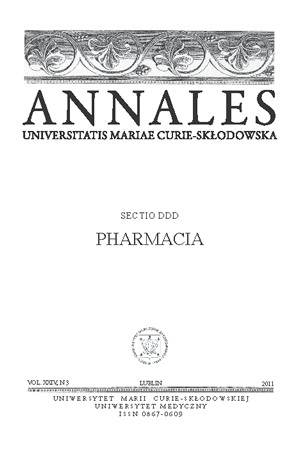Evaluation of the endoglin levels in maternal serum in preeclamptic pregnancies
DOI:
https://doi.org/10.12923/Keywords:
Endoglin, pregnancy, preeclampsia, angiogenic factorsAbstract
The objective of the study was to determine whether women with pregnancy complicated by preeclampsia have the different circulating levels of endoglin. The study was carried out on 41 preeclamptic patients (group PRE) and 41 healthy normotensive pregnant women without renal and cardiac diseases. The maternal serum endoglin concentrations were determined using a sandwich ELISA assay. There were no statistically significant differences in gravidity, parity, maternal age and height and BMI in patient profiles between groups. Maternal weight was lower in the control group of patients than in the group of preeclamptic patients. Systolic and diastolic blood pressure and mean arterial blood pressure were significantly higher in the study group of preeclamptic pregnant women than in the control group. Our study revealed the elevated levels of endoglin in serum of women with pregnancy complicated by preeclampsia. The mean values were 16.019 +/- 2.898ng/ml in preeclamptic patients and 10.963 +/- 4.0178ng/ml in the healthy controls. Preeclampsia is associated with higher maternal circulating levels of endoglin than normal pregnancy. These findings suggest that endoglin share a common pathogenic pathway as preeclampsia.
References
1. Aksoy K., Kumpte Y., Akçay F. et al.: Correlation of P-selectin and lipoprotein(a), and other lipid parameters in preeclampsia. Clin. Exp. Med 2, 39, 2002.
2. Bretelle F., Sabatier F., Blann A. et al.: Maternal endothelial soluble cell adhesion molecules with isolated small for gestational age fetuses; comparison with preeclampsia. Br. J. Obstet. Gynaecol. 108, 1277, 2001.
3. Foidart J.M., Schaaps J.P., Chantraine F. et al.: Dysregulation of anti-angiogenic agents (sFlt-1, PLGF, and sEndoglin) in preeclampsia - a step forward but not the definitive answer. J. Reprod. Immunol. 82, 106, 2009.
4. Gougos A., Letarte M.: Primary structure of endoglin, an RGD-containing glycoprotein of human endothelial cells. J. Biol. Chem. 265, 8361, 1990.
5. Gu Y., Lewis D.F., Wang Y.: Placental production and expressions of soluble endoglin, soluble fms-like tyrosine kinase receptor-1, and placenta growth factor in norma land preeclamptic pregnancies. J. Clin. Endocrinol. Metab. 93, 260, 2008.
6. Kassab S.E., Abu-Hijleh M.F., Al-Shaikh H.B. et al.: Hyperhomocysteinemia in pregnant rats: Effects on arterial pressure, kidneys and fetal growth. Eur. J. Obstet. Gynecol. Reprod. Biol. 122, 177, 2005.
7. Laskowska M., Laskowska K., Leszczyńska-Gorzelak B. et al.: Are the maternal and umbilical VEGF-A and sVEGF-R1 levels altered in pregnancies complicated by preeclampsia with or without intrauterine fetal growth retardation? Preliminary communication. Developmental. Period. Medicine. XII,1, 499, 2008.
8. Levine R.J., Lam C., Qian C. et al.: Soluble endoglin and other circulating antiangiogenic factors in preeclampsia. N. Engel. J. Med. 355, 10, 992, 2006.
9. Luft F.C.: Soluble endoglin (sEng) joins the soluble fms-like tyrosine kinase (sFlt) receptor as a pre-eclampsia molekule. Nephrol. Dial. Transplant. 21, 11, 3052, 2006.
10. Maharaj A.S., Walshe T.E., Saint-Geniez M. et al.: VEGF and TGF-beta are required for the maintenance of the choroids plexus and ependyma. J. Exp. Med. 205, 2, 491, 2008.
11. Masuyama H., Nakatsukasa H., Takamoto N. et al.: Corelation between soluble endoglin, vascular endothelial growth factor receptor-1, and adipocytokines in preeclampsia. J. Clin. Endocrinol. Metab. 92, 2672, 2007.
12. Maynard S.E., Min J.J., Merchan J. et al.: Excess placental soluble fms-like tyrosine kinase 1 (sFlt1) may contribute to endothelial dysfunction, hypertension, and proteinuria in preeclampsia. J. Clin. Invest. 111, 649, 2003.
13. Purwosunu Y., Sekizawa A., Farina A. et al.: Evaluation of physiological alterations of the placenta through analysis of cell-free messenger ribonucleic acid concentrations of angiogenic factors. Am. J. Obstet. Gynecol. 198, 124, 2008.
14. Reddy A., Suri S., Sargent I.L. et al.: Maternal circulating levels of activin A, Inhibin A, sFlt-1 and endoglin at parturition in normal pregnancy and preeclampsia. PLoS. One. 2, 2, 4453, 2009.
15. Report of the national High Blood Pressure Education program Working Group on high blood pressure in pregnancy. Am. J. Obstet. Gynecol. 183, S1, 2000.
16. Robinson C.hJ., Johnson D.D.: Soluble endoglin as a second – trimester marker for preeclampsia. Am. J. Obstet. Gynecol. 197, 174e1, 2007.
17. Smith G.C.S., Wear H.: The perinatal implications of angiogenic factors. Curr. Opin. Obstet. Gynecol. 21, 111, 2009.
18. Steinberg G., Khankin E.V., Karumanchi S.A.: Angiogenic factors and Preeclampsia. Thrombosis. Research.123, Suppl.2, 593, 2009.
19. Stepan H., Krämer T., Faber R.: Maternal plasma concentrations of soluble endoglin in pregnancies with intrauteirne growth restriction. J. Clin. Endocrinol. Metab. 92, 2831, 2007
20. Ten Dijke P., Goumans M.J., Pardali E.: Endoglin in angiogenesis and vascular diseases. Angiogenesis. DOI 10.1007/s10456-008:9101, 2008.
21. Venkatesha S., Toporsian M., Lam C. et al.: Soluble endoglin contributes to the pathogenesis of preeclampsia. Nat. Med. 12, 6, 642, 2006.
22. Wipff J., Avonuac J., Borderie D. et al.: Disturbed angiogenesis in systemic sclerosis; high levels of soluble endoglin. Rheumatology. 47, 972, 2008.
Downloads
Published
Issue
Section
License
Copyright (c) 2011 Authors

This work is licensed under a Creative Commons Attribution-NonCommercial-NoDerivatives 3.0 Unported License.


